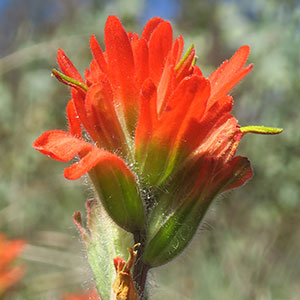Castilleja brevilobata
Castilleja collegiorum
short-lobed paintbrush
colleagues paintbrush, collegial paintbrush
solitary or few, erect or ascending, unbranched, sometimes branched, hairs spreading, short, medium, and long, soft, short and medium ones short stipitate-glandular.
few to many, erect or ascending, short-decumbent at base, unbranched, hairs dense, spreading to erect, ± short, soft, usually stipitate-glandular, longer ones sometimes eglandular.
green or ± yellow, lanceolate, elliptic, or oblong to narrowly ovate, 1–2(–2.5) cm, not fleshy, margins plane or wavy, involute, (0–)3–5(–7)-lobed, apex rounded to acute;
lobes ascending to erect, linear to lanceolate, apex rounded to acute.
pale green to dull reddish maroon, linear to linear-lanceolate, 0.8–3.5 cm, not fleshy, margins plane, slightly involute, 0–3(–5)-lobed, apex acuminate;
lateral lobes ascending to spreading, linear-lanceolate, usually arising from distal 1/2 of blade, usually narrower than central lobe, apex acuminate to acute.
3–20 × 2–3.5 cm;
bracts proximally greenish to dull brown, distally red, orange-red, or scarlet, sometimes orange or yellow, broadly lanceolate or oblong, (0–)3–5-lobed;
lobes ascending, broadly to narrowly lanceolate, short, arising above mid length, apex acute, obtuse, or rounded.
10–40(–80 with age) × 0.5–2.5 cm;
bracts pale cream to pale greenish yellow throughout, often partly to entirely suffused with dull reddish purple to maroon, especially proximally, along veins, and with age, sometimes distal apices pale, dullish red, lanceolate to ovate, usually 3-lobed, central lobe sometimes with short teeth;
lobes spreading-ascending, linear-lanceolate, short to medium length, arising at or above mid length, apex acute.
straight, 15–24(–26) mm;
tube 12–16 mm;
beak exserted, abaxial lip equal to calyx;
beak adaxially green or ± yellow-green, 7–10 mm, puberulent, stipitate-glandular;
abaxial lip deep green, reduced, rounded, 1–2 mm, 10–25% as long as beak;
teeth incurved to erect, light green, 0.5–1 mm.
straight, 16.5–25 mm;
tube 12–18 mm;
beak scarcely exserted, adaxially pale green to yellowish, 3–7 mm;
abaxial lip green, not inflated, grooved, 2.5 mm, 33–50% as long as beak;
teeth slightly incurved, white, 1 mm.
green or whitish with green veins, lobes colored as bract lobes or paler, 14–30 mm;
abaxial and adaxial clefts 5.5–8.5 mm, 30–40% of calyx length, deeper than laterals, lateral 1.5–4 mm, 20–25% of calyx length;
lobes oblong to narrowly triangular, apex obtuse to rounded.
pale cream to pale greenish yellow, sometimes reddish violet to maroon on distal segments and/or with a thin vertical strip of pale reddish violet to maroon along veins, 11–20 mm;
abaxial and adaxial clefts 7–12 mm, 60% of calyx length, deeper than laterals, lateral 0.5–1 mm, 5–10% of calyx length;
lobes triangular, apex acute to obtuse.
= 24.
Castilleja brevilobata
Castilleja collegiorum
Castilleja brevilobata is endemic to dry serpentine openings in the Siskiyou Mountains of southwestern Oregon and adjacent California. Although sometimes treated as part of C. applegatei or C. hispida, its morphology does not suggest a close connection with either. This species occasionally hybridizes with C. pruinosa in Del Norte County, California.
(Discussion copyrighted by Flora of North America; reprinted with permission.)
Castilleja collegiorum is endemic to a large meadow system in the southern Cascade Range of Klamath County. It is similar to C. cryptantha in Washington and C. lemmonii in California but differs from both in structural details of the inflorescence, calyx, bracts, and leaves.
(Discussion copyrighted by Flora of North America; reprinted with permission.)
- Local floras:
OR
- Local Web sites:
Flora NW,
PNW Herbaria
WildflowerSearch
iNaturalist (observations)
- LBJ Wildflower Center
- SEINet
- Plants of the World Online
- Encyclopedia of Life
- Wikipedia
- Google Image Search


